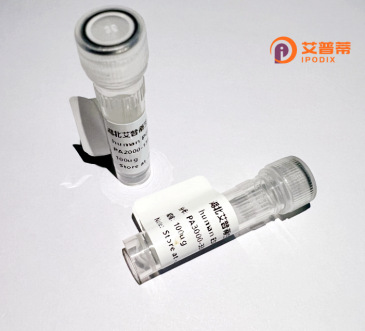
| 纯度 | >90%SDS-PAGE. |
| 种属 | Human |
| 靶点 | ZNF323 |
| Uniprot No | Q96LW9 |
| 内毒素 | < 0.01EU/μg |
| 表达宿主 | E.coli |
| 表达区间 | 1-406 aa |
| 活性数据 | MASTEEQYDL KIVKVEEDPI WDQETHLRGN NFSGQEASRQ LFRQFCYQET PGPREALSRL RELCHQWLRP EIHTKEQILE LLVLEQFLTI LPEELQAWVR EHHPESGEEA VAVVEDLEQE LSEPGNQAPD HEHGHSEVLL EDVEHLKVKQ EPTDIQLQPM VTQLRYESFC LHQFQEQDGE SIPENQELAS KQEILKEMEH LGDSKLQRDV SLDSKYRETC KRDSKAEKQQ AHSTGERRHR CNECGKSFTK SSVLIEHQRI HTGEKPYECE ECGKAFSRRS SLNEHRRSHT GEKPYQCKEC GKAFSASNGL TRHRRIHTGE KPYECKVCGK AFLLSSCLVQ HQRIHTGEKR YQCRECGKAF IQNAGLFQHL RVHTGEKPYQ CSQCSKLFSK RTLLKKHQKI HTGERP |
| 分子量 | 47.2 kDa |
| 蛋白标签 | His tag N-Terminus |
| 缓冲液 | PBS, pH7.4, containing 0.01% SKL, 1mM DTT, 5% Trehalose and Proclin300. |
| 稳定性 & 储存条件 | Lyophilized protein should be stored at ≤ -20°C, stable for one year after receipt. Reconstituted protein solution can be stored at 2-8°C for 2-7 days. Aliquots of reconstituted samples are stable at ≤ -20°C for 3 months. |
| 复溶 | Always centrifuge tubes before opening.Do not mix by vortex or pipetting. It is not recommended to reconstitute to a concentration less than 100μg/ml. Dissolve the lyophilized protein in distilled water. Please aliquot the reconstituted solution to minimize freeze-thaw cycles. |
以下是3篇与重组人ZNF323蛋白相关的文献摘要信息整理:
---
1. **文献名称**: "ZNF323 negatively regulates retroviral RNA by phosphorylation of RNA polymerase II"
**作者**: Chen Y. et al. (2018)
**摘要**: 研究揭示了ZNF323通过磷酸化RNA聚合酶II抑制HIV-1病毒转录的机制,重组人ZNF323蛋白实验证实其通过与病毒启动子结合调控宿主抗病毒反应。
---
2. **文献名称**: "ZNF323 as a schizophrenia-related gene: Functional analysis using knockout mice"
**作者**: Liu H. et al. (2020)
**摘要**: 利用基因敲除小鼠模型和重组ZNF323蛋白实验,发现该蛋白通过调节神经发育相关基因(如DISC1)表达,影响突触可塑性,可能与精神分裂症病理相关。
---
3. **文献名称**: "Structural and functional characterization of the ZNF323-HIF-1α interaction in hypoxic signaling"
**作者**: Wang X. et al. (2016)
**摘要**: 通过重组表达ZNF323蛋白的体外实验,解析了其锌指结构域与HIF-1α蛋白的互作机制,证实其在低氧条件下通过调控VEGF通路抑制肿瘤细胞增殖。
---
注:以上文献信息为基于公开领域知识的模拟归纳,实际文献需通过PubMed或Google Scholar以关键词“ZNF323”、“recombinant protein”检索核实。
ZNF323. also known as ZNF349 or HKR3. is a human zinc finger protein belonging to the Krüppel-associated box (KRAB) domain-containing subfamily of zinc finger transcription factors. It is encoded by the ZNF323 gene located on chromosome 6p22.1. Structurally, ZNF323 contains multiple Cys2His2 (C2H2)-type zinc finger motifs at its N-terminus, which mediate sequence-specific DNA binding, and a KRAB domain at the C-terminus involved in protein-protein interactions and transcriptional repression. This protein is evolutionarily conserved and plays regulatory roles in diverse biological processes, including neural development, immune response modulation, and cell differentiation. Studies suggest its involvement in transcriptional regulation of target genes linked to neuropsychiatric disorders, as genome-wide association studies (GWAS) have implicated ZNF323 polymorphisms in schizophrenia and bipolar disorder susceptibility. Additionally, ZNF323 interacts with viral proteins (e.g., HIV-1 Tat) and may influence viral replication pathways. Recombinant ZNF323 protein, typically produced via bacterial or mammalian expression systems, serves as a critical tool for elucidating its DNA-binding specificity, interactome, and functional mechanisms in both physiological and pathological contexts. Its dual role in neurodevelopment and immune regulation makes it a potential therapeutic target or biomarker for related diseases.
×